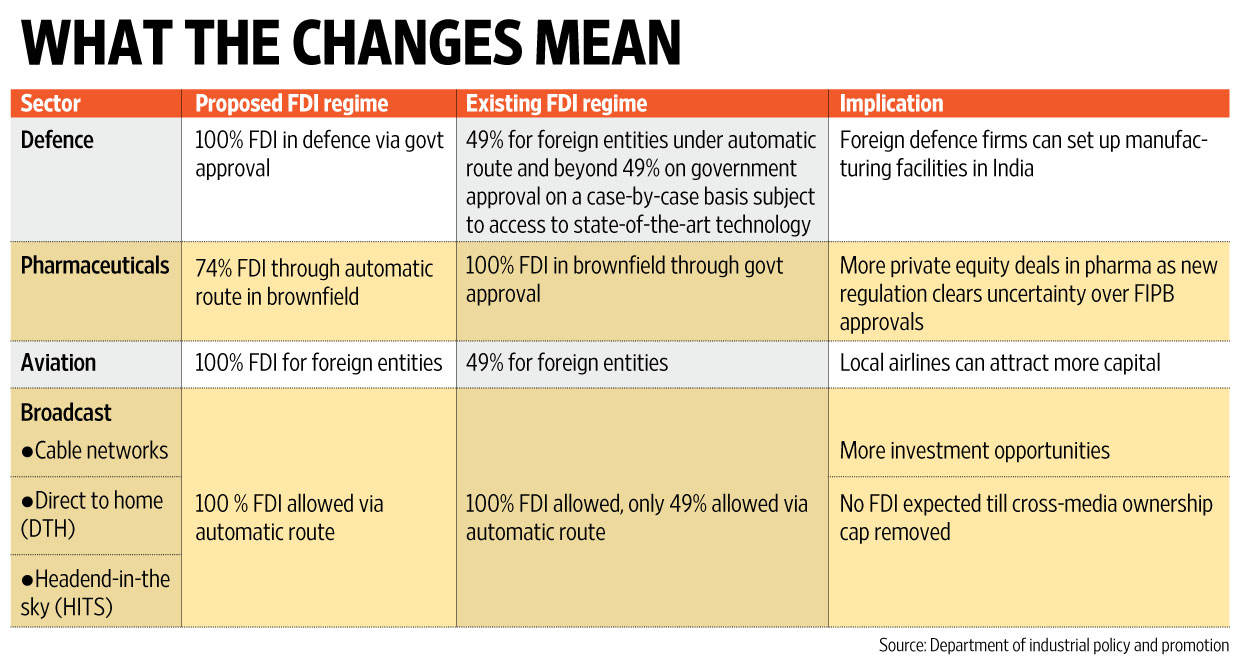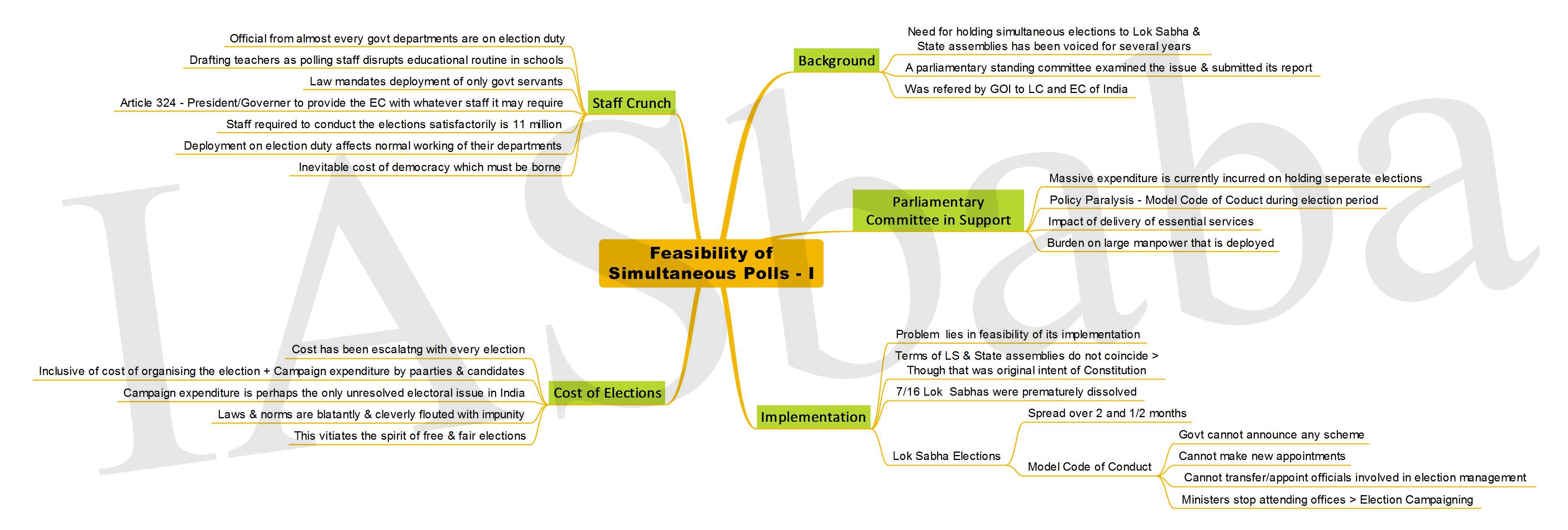IASbaba's Daily Current Affairs Analysis, IASbaba's Daily Current Affairs June 2016, National, Polity, UPSC
Archives
IASbaba’s Daily Current Affairs – 22nd June, 2016
ECONOMICS
TOPIC: General Studies 3
- Indian Economy and issues relating to planning, mobilization of resources, growth, development and employment.
- Effects of liberalization on the economy, changes in industrial policy and their effects on industrial growth.
- Investment models
The FDI Story
Statistics:
- FDI inflows into India rose to $55.46 billion in 2015-16 from $36.04 billion two years ago— FDI into the country has been going up steadily
- The top five sectors — services, construction, computer software and hardware, telecom and automobiles- accounts for a 45 per cent FDI share
FDI Liberalization
Easing entry of FDI: Government has taken a bold step in liberalising the foreign direct investment norms in nine key sectors (used to account 11 per cent of the total FDI received by India)— opens up the country to the global world
Ease of Doing Business staying true to its name: Boosting the economic growth
- More investments have been brought under the automatic route— will not entail prior approval
- Reduced bureaucratic discretion—Creation of an enabling environment
- Promises of Policy certainty— improve investor sentiment
- Creation of more jobs
Big mind-set shift: The move to prescribe a small negative list for FDI with most sectors under the automatic route
(Coverage in point format)
Defence—
Present:
- Permitted foreign companies to own 49% in Indian units through the automatic approval route
- Previously foreign OEMs (original equipment manufacturers) were required to form joint ventures with domestic firms if they wanted to establish a manufacturing base in India (an OEM can now independently plan and implement operations in India)
Changes:
- Allowed foreign companies to own as much as 100% equity in the local defence sector through the government approval route
- Applicable to manufacturing of small arms and ammunitions covered under Arms Act 1959
- The condition of access to ‘state-of-art’ technology in the country has been done away with
Implications:
- Provides global OEMs (original equipment manufacturers) strong incentive to establish substantial local manufacturing in India –
- With 60% of India’s defence requirements met through imports, local defence production is at the heart of the Make in India programme
- Increase in Joint ventures— lack of expertise can be tackled with
- More sense of ownership— encourage foreign defence equipment makers to open production centres leading to widening of the vendor base for local companies, increasing competition among suppliers for business, and better compliance with offset obligations
- Will help to allay fears on technology transfer
- Foreign players will be able to develop a local vendor base, with or without Indian partners
- Ensure availability of cutting edge technologies for the defence forces
- Boost to local manufacturing
- Assured returns for international OEMs
- Enhanced R&D to develop and deploy solutions catering specifically to the country’s security needs
- Removal of procedural hurdles:
- Removing the burden to prove the product/ technology as modern and state of the art
- Flexibility in examining proposals and giving approvals quickly— allow the government to look at proposals at more proactive basis
Concerns:
- Need to inject in a smooth process of an approval system
- Revenue front should be taken into account at every step
- More clarity on the issue if government will source from them
- Highly regulated export of defence items from India
Pharmaceuticals—
Present: allowed 100% FDI under the automatic route in green-field pharma (projects built from scratch) and up to 100% FDI in brownfield pharma projects under the government approval route
Changes: allowed up to 74% FDI under the automatic route for investments in brownfield pharmaceutical projects with investments beyond 74% under the approval route
Implications:
- Boost mergers and acquisitions (M&As) and private equity investments in the sector in future
- Small and mid-sized companies may see more interest both from promoters and buyers
- More clarity over ownership and removal of uncertainty
- High margins owing to the low cost of production in India— will increase the number and size of deals
- Incidences of international players getting into a partnership with local partners— a welcome change for global pharma players looking at establishing a presence in India but not looking for a 100% stake
- Stimulate more M&A and investment in CRAMS (Contract Research and Manufacturing Services)
Concerns:
- The limit could have been increased to 100% instead of 74%
- Need to streamline regulations, particularly Drug Price Control Orders (DPCO)
- Government should also take care of the following:
- Price control mechanisms
- Increasing use of compulsory licensing
- The perception of an unfavourable regime for protection of intellectual property rights in India
Civil Aviation—
Present:
- Up to 49% FDI is allowed under the automatic route in domestic airlines (scheduled air transport service/ domestic scheduled passenger airline and regional air transport service)
- The extant FDI policy on airports permits 100% FDI under automatic route in green-field projects and 74% FDI in brownfield projects under automatic route. FDI beyond 74% for brownfield projects is under government route
Changes:
- Allow overseas entities—excluding airlines—to own 100% in domestic airlines; with FDI up to 49% permitted under automatic route and FDI beyond 49% through government approval.
- For NRIs (non-resident Indians), 100% FDI will continue to be allowed under automatic route
- Investment by foreign airlines in domestic airlines will, however, be limited to 49% of paid-up capital
- Allowed 100% FDI under the automatic route in the brownfield airport projects (existing facilities requiring expansion and refurbishment)with the aim of modernize existing airports
- As equity holding of foreign airlines is still limited to 49%, a foreign airline can join hands with its sovereign fund or private investors and set up a 100% foreign-owned airline in India
Implications:
- Incoming of more funds
- Modernization of existing airports—more upgradation of airport infrastructure is to make operations viable
- Expansion in their fleet
- Increase in competition will bring down prices and enhance air penetration in India—both international and domestic
- Enhanced valuations— when raising funds or going for partial or complete divestment
- Inclusion of best practices
- Support initial public offerings without worrying about foreigner ownership limits
- Foreign airlines can now focus on the customers and competition rather than wasting time on legal and regulatory issues
- Value being given to market forces— while the government keeping its concerns limited to issues like aviation safety, security and consumer interests
Concerns:
- The 49% FDI still remains under-utilized
- Issue of Indian promoters giving up too much stake and when things go bad, foreign investors not finding such investments attractive to be a part of
- Government should additionally also take up measures for
- Reducing cost of doing business like rationalisation of input costs
- Providing relaxation to existing airlines in other rules (on directors, route dispersal norms, minimum domestic flying, on grandfathered schedules and routes, crew flying permits, among others) to attract foreign capital
- Restructuring of AAI— critical to allow long-term capital flows
Broadcast—
Present:
- Need for prior approval of foreign investment in the broadcasting sector
- Investments were subject to approval from the Foreign Investment Promotion Board (FIPB)
Changes: Allowed 100% FDI via automatic route for broadcasting carriage services— direct-to-home (DTH) TV operators, cable network companies and mobile television firms to raise 100% FDI under the automatic route
Single-brand retail—
Present: companies opening wholly-owned stores in India were required to comply with the local sourcing norms of 30% within five years of their first store opening
Changes:
- Government has made it easier for single brand retailers to setup operations in the country with an extended window of eight years before the application of the local sourcing norms come into play (firms with state-of-the-art and cutting- edge technology)
- Limited the exemption to three years for entities undertaking single brand retail trading and seeking exemption from local sourcing norms — get a waiver only for three years along with a relaxed sourcing regime for five more years (to encourage such manufacturers to source from India)
- Made it easier for retailers setting up under 100% single brand policy
- 100% FDI under approval route for trading, including through e-commerce for food products manufactured or produced in India (as announced in the Budget as well)
Implications:
- Setback for the companies in the technology space— were hoping for a complete waiver on the grounds that the products proposed to be sold involved state of the art technology
- Companies manufacturing food products in India will be allowed to set up retail stores and even have e-commerce operations w.r.t. the items manufactured in India— a progressive step as companies like Wal-Mart Inc which have cash and carry wholesale operations and are ruled by the multi-brand retail policy— will readily consider food retail in India
Concerns: Tough regulatory environment

Image Courtesy: http://www.livemint.com/r/LiveMint/Period2/2016/06/21/Photos/Processed/web_fdi.jpg
NATIONAL/POLITY
Topic: General Studies 2
- Parliament and State Legislatures – structure, functioning, conduct of business, powers & privileges and issues arising out of these.
- Salient features of the Representation of People’s Act
Revisiting the role of Rajya Sabha
The Parliament of India consists of President, Council of states (RS) and House of People (LS).
At present Rajya Sabha has a strength of 245 members (States – 229; UTs – 4; Nominated – 12). Every second year one third of its members retire and fresh elections are conducted for vacant seats.
The upper house also called second chamber or House of elders represents the states and union territories.
Rajya Sabha has been created with the following objectives.
- To maintain federal equilibrium by protecting the interests of the states against the undue interference of the centre.
- To facilitate giving representation to eminent professionals and experts who cannot face direct elections.
- To check the hasty, defective and ill-considered legislation made by Lok Sabha.
Vision of founding fathers
The vision of founding fathers of our constitution can be traced in Constituent Assembly (CA) debates. Following are the views and ambitions put out by various leaders or the way in which they saw this institution.
- A house of reflective and evaluative reasoning, “The genius of people may have full play” and it can be make place for “who may not be able to win the popular mandate”.
- “A sobering house, a reviewing house, a house standing for quality and members will be exercising their right to be heard on the merits of what they say, for the sobriety and the knowledge of special problems”
- To initiate proposals for public policy, to elicit responsiveness from public authority, and to hold governments accountable.
- The house is seen as an authoritative platform to accommodate diversity, which is an essential ingredient.
Whether Rajya Sabha has lived up to the expectations?
In several occasions Rajya Sabha proved its merits in Indian polity, where it has acted as an important platform of resistance to the majority rule in Lok Sabha. But also the performance of this institution has been criticized for many reasons which include –
- Blocking and delaying of key legislations for purely political reasons –
- Back door entry for those who cannot win the elections.
- Corruption in the election of members to this house (Magnified recently) and
- Tendency of political parties to pack the house with their high and mighties without consideration to their being worthy or not to play the representative role.
- Majoritarian rule of the Lok Sabha since 1970 till present.
- Increased cost of legislation.
Some instances of resistance to the legislation of LS can be remembered here.
- Prevention of Terrorism Bill in 2002 (Bill defeated in RS and passed in Joint sitting (JS)). Two other cases where bills passed in JS are ‘Dowry prohibition bill 1960’ and ‘ Banking service commission (Repeal) bill 1977’
- Corruption charges against the government during 201114, and
- The proposed amendment to the Land Acquisition, Rehabilitation and Resettlement Act in 2015.
Such instances may lead to a perception that, the electoral victory to the lower House may entitle a party to rule but not necessarily govern unless it reaches out and engages with the central concerns and interests embedded in the polity.
What Powers Rajya Sabha have?
Following are some of the exclusive powers of RS
- Power to transfer a subject from the State List to Union List for a specified period (A-249)
- Create additional AllIndia Services common to both the centre and states (A-312),
- Endorse Emergency under Article 352 for a limited period when the Lok Sabha remains dissolved.
Equal status with lok sabha in matters of Ordinary bills, Constitutional amendment bills, election and removal of various constitutional heads etc.
Unequal status with lok sabha in matters of Money bill, Joint sitting, emergency provisions, disproportionate share in various committees.
In 2006, Supreme court upheld the removal of domicile requirement mandated by RPI Act 1951. This is seen as a great hit to the mark of diversity that was the hall mark of this house.
How Rajya Sabha should be?
- It should be the voice of sanity, of the excluded and of citizen’s rights.
- It should ensure that the majoritarian thrust of the lower house does not undermine rule of law and public institutions.
- It should preserve the essence of diverse representation (which seems to be diminishing after 2006 SC verdict).
Observing the sorry state of affairs in the recent elections in which saw the money game and dirty politics, there are genuine worries about credibility of this institution. Hence it is felt that, the nature and role of RS should be revisited, rather than merely think it as the parking lot for those who cannot ensure their election from a popular constituency.
Way Ahead:
- Rajya Sabha could be the House that represents difference in our polity, difference marked not merely by its culture but its diversity but also in its inegalitarian social relations.
- The representation of constituencies like: Muslims? women? Linguistic, religious and ethnic diversity? regions such as the Northeast and Jammu & Kashmir? Urban informal labour? the rural poor etc., who cannot go for direct elections must be ensured.
Connecting the dots:
- “Rajya Sabha has turned out to be another chamber of the parliament akin to the lok sabha, except for the mode of selection of its members”. Evaluate.
Also Read-
Rajya Sabha and Bad Monsoon memories
MUST READ
The mat goes mainstream
Banking revival must be a priority
Potential impact of model GST law
Related Articles:
http://iasbaba.com/2015/11/iasbabas-daily-current-affairs-12th-november-2015/
http://iasbaba.com/2015/07/iasbabas-daily-current-affairs-18th-july-2015/
http://iasbaba.com/2016/03/big-picture-gst-bill-still-not-passed/
FDI liberalization is one part of the puzzle
Related Articles:
Five charts on the state of India’s housing sector
Related Articles:
City infrastructure: With a multifaceted approach we can afford the ‘Housing for All’ dream
All India Radio – Issues Relating to Real Estate Sector
The permanence of temporary workers
Kabul’s doors are closing on Pakistan
MINDS MAPS
1. Feasibility of Simultaneous Polls – I















